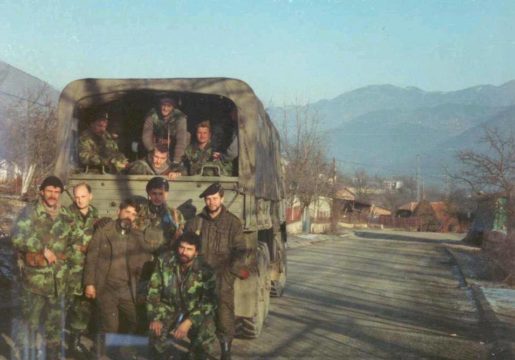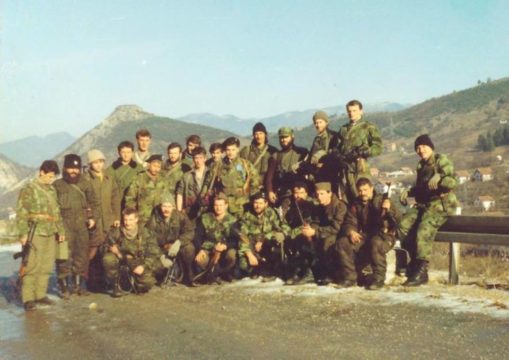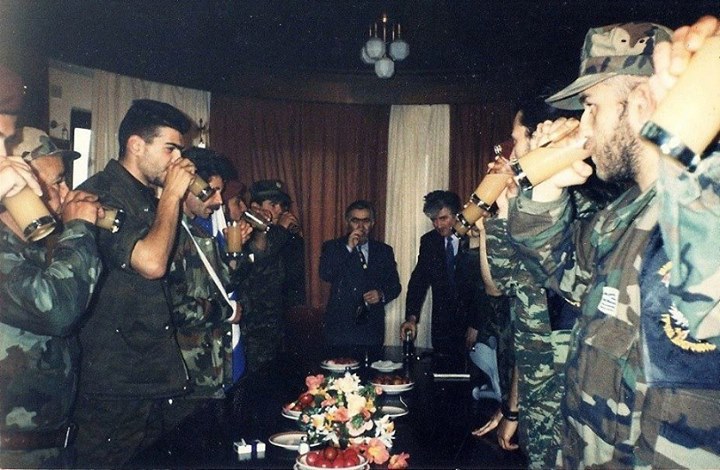Given the shortage of manpower on the front line, the Greater Serbia aggressor and its collaborationists had brought in and involved foreign mercenaries (foreign nationals) into combat activity, too. Based on the data
available, we can surely claim that the composition of the aggressor’s units also included foreign citizens — mercenaries, mainly Ukrainians, Russians, and Romanians. The recruitment of foreign nationals for the aggression against the Republic of Bosnia and Herzegovina was the job of a specialized agency in Belgrade, managed by Vojislav Seselj. [1]
Organized recruitment of foreign nationals into the units of the Army of Republika Srpska went through the Bureau of Republika Srpska in Belgrade, [2] among others, also employing Major Jovan Djogo. He was in charge of military issues of interest for this collaborationist army, including the receipt of volunteer soldiers from the Federal Republic of Yugoslavia and other East European states, and of their sending to Bosnia and Herzegovina. [3] From this Bureau, foreign mercenaries were sent, mainly to the Main Headquarters of the Army of Republika Srpska (personally to major Mico Grubor, who was chief of staff of the personnel administration of the Main Headquarters of the Army of Republika Srpska ), from where they were forwarded to the corps. [4]
Among the victims in the aggressor’s attack on Jajce, in late October 1992, nine soldiers were identified as being nationals of Ukraine, Russia, and Romania. The testimony by one of the detained soldiers who had arrived to the Jajce front line from Ukraine states that he had been recruited through a specialized agency in Belgrade, in charge of recruitment of foreign nationals in the aggression against Bosnia and Herzegovina, and that together with 15 of his friends, he was supposed to receive 3,000 DM from that same agency after the fall of Jajce. Similar statements were given in September 1992 to the investigative bodies of the Army of the Republic of Bosnia and Herzegovina by some Romanian citizens too, arrested during the aggressor’s attack on the Sarajevo residential area of Stup. [5]
The aggressor was continually bringing in permanent contingents of foreign mercenaries onto the Bosnian-Herzegovinian war front, thus filling in their units. Thus, in mid-summer of 1992, among the Serb “volunteer units” on the territory of Ilijas, commanded by Ratko Adzic, there were also active military formations from Ukraine. These mercenaries, dressed in black uniforms, committed mass crimes against Bosniaks, in addition to infantry arms, also using objects for torture and inflicting of serious bodily injuries, such as, for instance, sticks for pulling out of eyes, and the like. [6]
In the first half of November 1992, the aggressor brought in a new contingent of foreigners: 600 Romanians to Mt. Ozren, and 200 Russians to Vogosca. The mercenaries from Romania, Russia and Ukraine also participated in the attacks on Mt. Zuc in the first half of November of 1992. [7]
From October 25, 1992, until April 26, 1993, Sergei Victor Sukharov (a Russian) “ participated in the combat activities of the Army of Republika Srpska ”. [7a]
In its aggressive attack on Mt. Zuc, in the second half of January 1993, the aggressor had some 200 Russians amongst its ranks, too. At the same time, a number of Ukrainians were found in Ilidza, whereas in early February a whole detachment of 600 Russians arrived in Kalinovik, and “ 17 Russian special forces arrived in Zvornik, from where they were immediately transferred to the neuralgic areas in the region of Srebrenica ”. It is also necessary to indicate upon the fact that a large number of the Ukrainians, who were recruited in the composition of the UNPROFOR units in Bosnia and Herzegovina, after returning from the “peacekeeping” missions, changed their clothing with the UN emblems for the clothing of the Serb fascist volunteers , where they killed Bosniaks, raped their women, destroyed, plundered and burned down their villages and cities, and also committed other crimes. [8]
In early 1993, there were also some 2,500 Russian mercenaries among the aggressor ranks on the front line in Bosnia and Herzegovina. Of this number, some 150 of them were on Mt. Majevica only. In the large-scope Serb offensive on Teocak, in the first half of March 1993, the artillery weapons were operated by the Russian mercenaries as members of two Chetnik brigades. [9] During the Serb offensive on Olovo, there was “ mention of arrival ” of 2,000 Russian mercenaries in Ilijas. At Grbavica, too, there were a number of Russian units. [10] A sergeant major Bikov became a captain and a “ tank commander ” in the “ Army of the Bosnian Serbs ”. Special Forces member Igor Vasilievich Guskov trained the special units in Bijeljina. After he participated in the aggressor ranks in the Northeast Bosnia, he went to Drvar and took part in the offensive activities on Mt. Grabez near Bihac. The combat activities on the line of Loncari-Orasje saw participation of a detachment consisting of Russian mercenaries, commanded by Mikhail Posthimanov. In addition, on the side of the Serb aggressor, there were also many other Russian special forces members participating, such as the case on the territory of Northeast Bosnia, where Russian mercenaries were hired as crews and commanders of the artillery batteries. [11]
A group of Kazaks (some 400 of them), led by ten Russian special forces officers, in early March 1993, took part in the offensive actions in the areas of Orasje and Gradacac. [12] In addition, the Kazaks also took part in the aggressor’s attack on Mt. Trebevic, then in the vicinity of the Vrbanja Bridge, and at Stupsko Hill on the territory of the Sarajevo city. [13]
In the second half of 1994, a number of Russians (Roman Malishev, Yuriy Sarapov, Denis Kvartzov, and others), participated in the attack on Mosevacko Hill. [14] Even during 1995, foreign mercenaries were coming to Bosnia and Herzegovina, where they participated in the armed attacks against the Republic. [15]
Several Russians and Greeks also participated in the attack and takeover of the UN “safe area” of Srebrenica, from July 6 through 11, 1995. [15a]
2nd Volunteer Russian Detachment - Višegrad
2nd Volunteer Russian Detachment - Višegrad
2nd Volunteer Russian Detachment - Višegrad
2nd Volunteer Russian Detachment - Višegrad
3rd Volunteer Russian Detachment - Sarajevo
3rd Volunteer Russian Detachment - Sarajevo
Srebrenica Bosnia And Herzegovina 11 July 1995 Greek Volunteers
Zvonko Bajagic, Ratko Mladic, and Antonis Mitkos - Srebrenica 11 July 1995
April 1994, Pale, Bosnia And Herzegovina; Radovan Karadzic, Momcilo Krajisnik, and Greek Volunteers
April 1994, Pale, Bosnia And Herzegovina; Radovan Karadzic, Momcilo Krajisnik, and Greek Volunteers
April 1994, Pale, Bosnia And Herzegovina; Radovan Karadzic, Momcilo Krajisnik, and Greek Volunteers
References:
1. Press-centar Armije Republike Bosne i Hercegovine , 102/02-79; Ibid., no. 102/02-239, October 28, 1992; Oslobodjenje, March 13, 1993, and March 1, 1994; AIIZ, inv. No. 2-793.
2. AIIZ, inv. Nos. 5342, and 5352, Record, Supplemented Testimony by Dj. Dj. This Bureau was formed in 1992. The first chief was Dutina, and then Momcilo Mandic. For a time, the Bureau was formally under jurisdiction of the “ Government ” of the Republika Srpska, and later on, by the decision of R. Karadzic, president of the Republika Srpska, it was promulgated into an “institution of the republic, not the Government”. It was located on Mose Pijade St., in the Federal Commodities Reserves Building, and it had some 25 employees (AIIZ, inv. No. 5352, Record, Supplemented Testimony by Dj. Dj.). The Bureau was dealing with the issues related to the needs of citizens, and resolving a number of issued for the needs of the collaborationist Republika Srpska . Thus, this body provided various travel documents and organized visits for the representatives of the Republika Srpska to other countries, then, reception of humanitarian aid from Yugoslavia and abroad, taking care of the injured after they are released from hospitals and rehabilitation centres, arrivals of foreign journalists and politicians who visited Republika Srpska, and the like. Major Djogo was in charge of resolving all of the military issues for the needs of the Army of Republika Srpska in Belgrade. In February 1993, he was injured on Mt. Jahorina, from where he was transported by a JNA helicopter into Belgrade, and was taken to the Military Medical Academy for treatment. After rehabilitation, he took over the aforementioned duty at the Bureau. All arrangements or linkages were secured through him by which military conscripts were returning to Republika Srpska. In this way, people were mobilized with the use of force and taken to the Bijeljina Barracks (4,500 mobilized for the Republic of Serb Krajina , and 1,500 for Republika Srpska, where, after they received military clothing, they were taken by vehicles into the units they were deployed in (Ibid.; AIIZ, inv. No. 5342, Record, Supplemented Testimony by Dj. Dj.).
3. AIIZ, inv. No. 5342, Record, Supplemented Testimony by Dj. Dj.
4. Ibid. The units determined to receive of mercenaries were: White Eagles, the Commando Detachment of the Sarajevo-Romanija Corps, commanded by Major Srdjan Knezevic, then the 1st Sarajevo Brigade (into the unit of count Slavko Aleksic, who held the line at the Jewish Cemetery), and “ sometimes some of the brigades of the Sarajevo-Romanija Corps... ” (Ibid.).
5. Press-centar Armije Republike Bosne i Hercegovine , 102/02-79; I bid., no. 102/02-239, October 28, 1992; Oslobodjenje, March 13, 1993, and March 1, 1994; AIIZ, inv. No. 2-793.
6. Daily Report, no. 56, June 19, 1992.
7. Press-centar Armije Republike Bosne i Hercegovine , 102/02, November 16, 1992.
7a. AIIZ, inv. No. 2-3033, Command of the 2nd Light Infantry Brigade, records no. 08-357/93, April 25, 1993, CERTIFICATE. Major Boro Antelj, commander of the 2nd Light Infantry Brigade, on April 25, 1993, issued the CERTIFICATE confirming that in the aforementioned period Sukharov “ participated in the combat activities of the Army of Republika Srpska “ and stated that “ he still retains the status of the soldier of the Army of Republika Srpska... “ (Ibid.). Rajko Mijanovic, assistant commander for intenlligence and security affairs of the Command of the 2nd Light Infantry Brigade, on September 20, 1993, issued the APPROVAL for Sergei Sukharov “ to purchase for his own needs, in the value of 200 DM, of the following items: coffee, cigarettes, tobacco “ (AIIZ, inv. No. 3-3033/1, Command of the 2nd Light Infantry Brigade, confidential, no. 09-666, dated September 20, 1993, APPROVAL). Sukharov had a passport issued by the World Service Authority, no. 233108, issued on October 21, 1991, by the USA office in Washington (Washington D.C., USA). This document (issued by the World Service Authority Administration of the World Government of World Citizens ) was valid for travel to all countries, unless they required a visa. The document could not be assigned to another person. The address stated on the visa application was: THE FOREIGN LEGION (AIIZ, inv. No. 2-3033/2-6).
8. Press-centar Armije Republike Bosne i Hercegovine , 102/02-780, January 26, 1993. During 1993, four Russians, two Bulgarians, and one Romanian arrived to the Sarajevo-Romanija Corps (AIIZ, inv. No. 5342, Record, Supplemented Testimony by Dj. Dj.).
9. Oslobodjenje, March 13, 1993.
10. Oslobodjenje, March 1, 1994. A foreign reporter observed the transfer of a number of Russian units onto Grbavica. After he “identified” this, he tried to film them, but, he was subjected to a number of troubles because of that.
11. Press-centar Armije Republike Bosne i Hercegovine , 102/02-1054, March 7, 1993; Oslobodjenje, March 1, 1994.
12. Ibid. It is interesting to point out that, for instance, near Teocak, the soldiers of the Army of the Republic of Bosnia and Herzegovina observed that the Serb criminal commanders had made particular efforts to remove the corps of some of the killed fascists from the front lines. These were in fact the corps of the killed Russians from the mercenary battalion, with some 300 of manpower (Ibid.).
13. Oslobodjenje, March 1, 1994.
14. AIIZ, inv. No. 2-2390, Command of the Detachment of the SRK, strictly confidential, no. 01/511, October 17, 1994, to the Command of the SRK. In that year, five Russians and one Bulgarian arrived in the Sarajevo-Romanija Corps (AIIZ, inv. No. 5342, Record, Supplemented Testimony by Dj. Dj.).
15. AIIZ, inv. No. 5342, Record, Supplemented Testimony by Dj. Dj.. Thus, in that year, three Russians and one Greek arrived in the Sarajevo-Romanija Corps (Ibid.).
15a. AIIZ, inv. No. 2-3070, Army of the Republic of Bosnia and Herzegovina, Command of the 2nd Corps, RRPSt “OKRESANICA”, strictly confidential, no. 06/7795, July 7, 1995 — to the Intelligence Body of the 2nd Corps, RI Daily Report, p. 59; Ibid., inv. No. 2-3072, Army of the Republic of Bosnia and Herzegovina, Command of the 2nd Corps, RRPSt “OKRESANICA”, strictly confidential, no. 09/11795, July 11, 1995 — to the Intelligence Body of the 2nd Corps, RI Daily Report. After the armed forces of the Serb Republic (the units of the army and the police), with cooperation of he units from the Federal Republic of Yugoslavia, as well as the volunteers from Russia and Greece, took the UN safe area of Srebrenica on July 11, 1995, Karadzic in person (“ for the purpose of marketing, he needs it for some purposes” ) ordered that in Srebrenica, in addition to the Serb flag, a Greek one should also be posted, whose members (that is, the Greeks), in addition to others, also participated in the attack and takeover of Srebrenica (Ibid., inv. No. 2-3071, Army of the Republic of Bosnia and Herzegovina, VJ 5022/5, strictly confidential, no. 05/1107, KONJUH, July 11, 1995, REPORT; Ibid., inv. No. 2-3072, Army of the Republic of Bosnia and Herzegovina, Command of the 2nd Corps, RRPSt “OKRESANICA”, strictly confidential, no. 09/11795, July 11, 1995 — to the Intelligence Body of the 2nd Corps, RI Daily Report.















